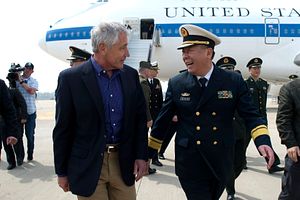If the PLA is serious about transparency, it will have to do more than allow Chuck Hagel to tour its symbolic aircraft carrier.
At first I thought it was an April Fool’s joke–then I realized the date. Then I realized there was no reason to even get excited in the first place.
The reason for my initial excitement: U.S. Secretary of Defense Chuck Hagel’s recent visit to China’s only aircraft carrier, the Liaoning. While certainly a milestone in allowing access to one of Beijing’s most prized naval acquisitions in recent times, it actually shows how far China needs to go when it comes to being more transparent in all aspects of its military (this includes its budget, procurement, strategic doctrine etc).
First, for the good part of this story. Hagel, according to various reports, was the first foreigner to go aboard the much discussed vessel, and apparently at Washington’s request.
While Flashpoints readers know the story of this vessel quite well, the visit adds another interesting historical tidbit to the former Soviet, former Ukrainian vessel. According to the DoD’s website, the tour lasted approximately two hours. It began with a briefing discussing the vessel, its various capabilities and its operating schedule. The briefing was led by the carrier group commander and the ship’s commanding officer, Capt. Zhang Zheng.
“We didn’t see every space aboard the ship. But, yes, we felt this was an honest, genuine effort to be open about this brand new capability that they’re trying to develop,” noted a U.S. official in a report for Reuters.
Besides Secretary Hagel, new U.S. Ambassador Max Baucus was also aboard the pride of China’s growing navy.
My question: Why now? One possible explanation: Beijing was returning the sentiment.
According to a recent article in the New York Times, the U.S. “held an extraordinary briefing for the Chinese military leadership on a subject officials have rarely discussed in public: the Pentagon’s emerging doctrine for defending against cyberattacks against the United States — and for using its cybertechnology against adversaries, including the Chinese.” According to the piece, the idea was to “allay Chinese concerns about plans to more than triple the number of American cyberwarriors to 6,000 by the end of 2016, a force that will include new teams the Pentagon plans to deploy to each military combatant command around the world.” The piece went on to explain that the U.S. had held the briefing in the hope that China would reciprocate the move. While China may be leery to reciprocate considering how lucrative cyber operations have reportedly proven in recent years, the visit by Hagel to China’s new carrier could be interpreted as substitute. It might just not have been the move Washington was hoping for.
Although we should certainly applaud both sides’ efforts to create an atmosphere of greater transparency, there is still a long way to go–especially from the Chinese side.
While Beijing might have been attempting to reciprocate earlier U.S. efforts, they did not exactly pick the greatest military concern for U.S. defense planners. In fact, China’s carrier at this point is really no threat at all—it’s more of a symbol of what is to come. In order to be a threat, you need to have a fully working air wing, an actual carrier group, and some means to defend it. Until those things are in place, China’s new carrier is simply a down payment on the future–nothing more.
So what other steps could Beijing have undertaken to reciprocate Washington’s move or show real transparency? If China did not want to give a tour of its cyber operations, it has many weapon systems that would have been more meaningful than China’s sole symbolic carrier. Here is an idea: give a tour of the facilities or weapons that actually are driving the rise of China’s military. Don’t show Secretary Hagel your one and only vulnerable carrier, show him the DF-21D, the actual carrier-killer. If China wants to drive greater stability in the region and head off a potential arms race or bandwagoning with Washington, it should open up on items that are actually driving Washington and its allies’ fears.
Sorry Flashpoints readers, I am not impressed.
































